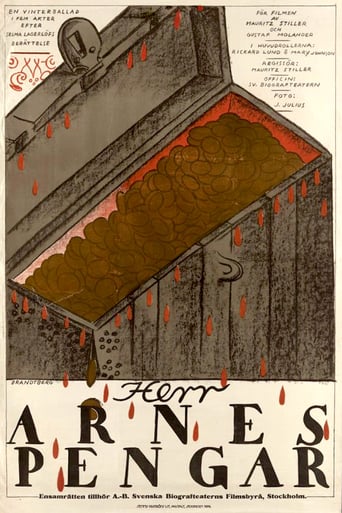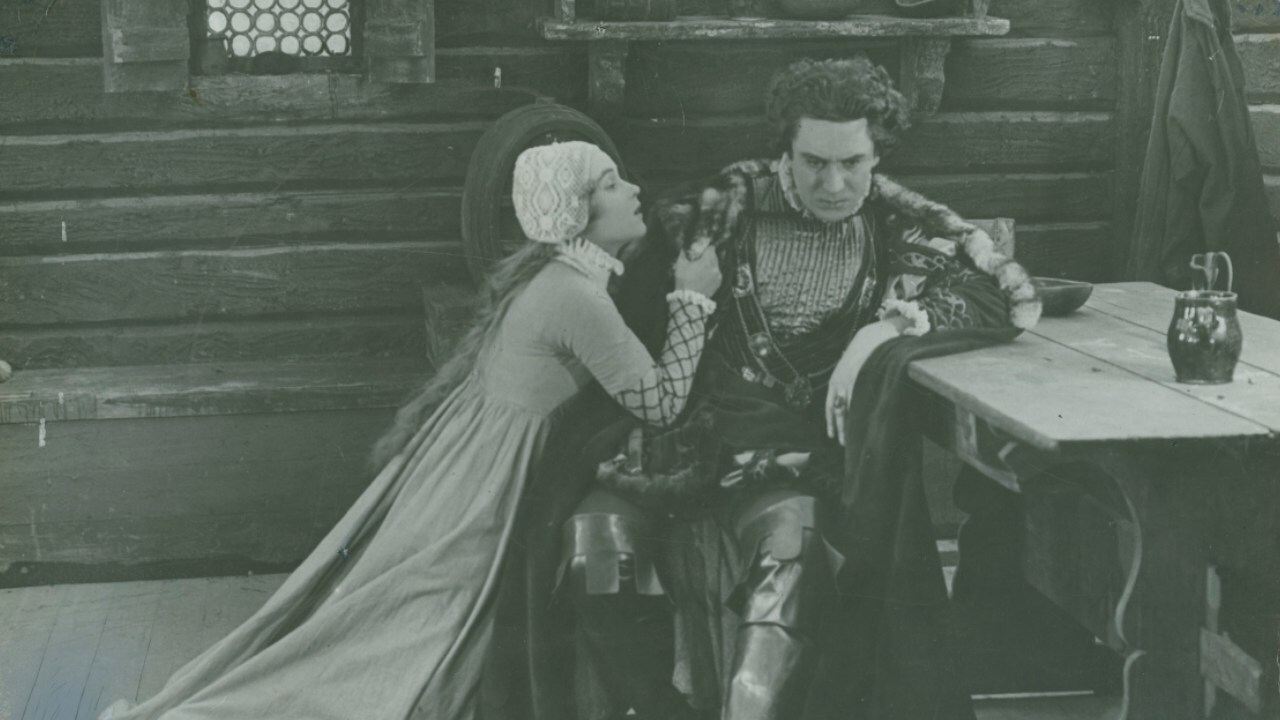MartinHafer
Technically speaking, this is a well-made film--especially for 1919. Yet despite this, I found myself curiously unengaged in the film. I think a lot of this is the plot, as it has two problems. First, it's unrelentingly depressing and the characters are hard to care for one way or the other. Second, the main bad guy and the woman he subsequently falls in love with are both ill-defined characters and both behave very inconsistently.The film starts in Sweden centuries ago. Large numbers of Scottish mercenaries had come there to work in the service of the king. However, some sort of falling out occurs. While most of these men flee the country, three Scots are locked up together. They eventually kill their jailers and escape. Considering it's winter and a harsh one at that, the fact that the three manage to survive to the border is amazing.Hungry and dehumanized, the trio learn of a rich man named Sir Arne who has a huge treasure chest. They take him and his family prisoner--eventually killing all of them (or so they think). One, a young lady, hides and manages to avoid death. Despite this traumatic incident, the lady oddly cannot readily identify the three murderous thieves--so when she meets and falls in love with one of them only days or weeks later, it makes little sense. Also what makes little sense is that almost all of this powerful action isn't shown! Perhaps it originally did and was simply lost over time--a common occurrence with silent films. But, without these scenes the movie just seems a bit lacking.Eventually, when the lady does learn that her depression and agony was caused by the man she now loves, she responds in an odd way. She STILL loves him! And, odder still, this supposedly transformed man who has turned over a new leaf quickly betrays this woman AGAIN--using her as a human shield to make his escape when the authorities come to arrest him for murder! Eventually, he manages to make it to a waiting boat but it is stuck in the ice--the intervention, apparently, by God who wants the three men caught and punished for their wickedness.What has the film going for it? Well, for a print over 90 years old, it sure is in excellent shape. It's obvious that the folks who restored the print did a great job. Plus, some of the cinematography was very nice. I was particularly impressed by the fine winter scenes--it must have been really tough filming in such inclement weather. But, on the negative side, the story often makes little sense as the characters behave strangely. And, often, the action is muted by the style in which the film was made. Finally, being unrelentingly depressing, this film is NOT one to show to anyone clinically depressed--it might just send them over the edge!
MARIO GAUCI
As far as I can tell, this is the first Swedish Silent that I've watched (I'd previously been intrigued by a solitary still actually used for the DVD sleeve itself found in "The Movie", a British periodical from the early 1980s); I've seen a handful of early efforts from neighboring Denmark and the aesthetic starkness in the predominant style of both countries is pretty similar. It's also the first from Swedish master Stiller (I also own his two other well-known titles, EROTIKON [1920] and THE SAGA OF GOSTA BERLING [1924], that were released on DVD from Kino and I may very well include the latter in my current Epic/Historical films schedule); incidentally, I've only checked out and was duly impressed by two American-made pictures from Victor Sjostrom, the other great director to emanate from this country during the Silent era.SIR ARNE'S TREASURE is best described as a historical melodrama since the elements typically expected of an epic only really come into play in the scenes involving a fire early on and a sword-fight towards the end. However, one shouldn't overlook the vast and forbidding icy landscape which not only serves as an extremely realistic backdrop to the narrative incidentally, the quality of the cinematography throughout likens the film to an uninterrupted series of medieval tableaux but is very much another character in it, since the villains' flight (the perpetrators of a massacre in a household, from which they also abscond with the titular fortune) is prohibited because the sea has frozen over! Notable scenes here include: a cart-wheeling horse falling head-first through cracked ice; the youngest of the thieves having ghostly visions of one of his murdered victims (as it happens, he later falls for the girl's sister
and she with him, which leads to the latter being torn whether to give her lover away or run off with him to Scotland!); the leading man ultimately using the heroine as a human shield against the oncoming soldiers; the closing procession over the ice by the townsfolk to reclaim the girl's dead body (justly considered one of the visual highlights in all of Silent cinema).The plot also effectively incorporates the element of premonition such as when the fish-hawker's usually docile canine companion senses impending doom and starts to howl, Sir Arne's wife literally hearing from miles away the preparations for the subsequent assault on her abode, the ship captain's tale of a previous case of poetic justice similarly brought on by severe weather conditions, and the heroine being led by her dead sister to the villains' whereabouts in a dream. The print I watched featured nice use of blue (for outdoor night-time scenes) and red (the afore-mentioned blaze) tinting; the newly-composed accompanying score is appropriately sweeping, albeit making use of mostly modern instruments. The main extras on the Kino DVD involve noted film historian Peter Cowie, who supplies an informative background to early Swedish cinema (where he also discusses the seminal contribution of authoress Selma Lagerlof who was behind the source novel of both this and THE SAGA OF GOSTA BERLING) and, in a separate featurette, focuses exclusively on the film at hand.
tedg
I suppose no one can understand film at all without knowing the poles of narrative.One of the dimensions is whether the world is beside the story and viewed by it. Or in some other relationship. The Swedes own one of these poles, their narratives always being buried by heavy fate and guilt about it. Its a very strange thing to see from the outside.The nature of Swedish narrative survives today, because they are so good at nurturing and presenting it. And we watch it for some reason, possibly because of the lightness of being outside the curse. The story here is of three alien murderers who decimate a peaceful household for the titular treasure. One of these thugs later falls in love with the soul surviver, a pretty girl.She feels guilty for surviving, he for murdering and both for falling in love. The meaty part of the story is toward the end where guilt drives fate and the world comes crashing down on them. The whole world contrives against them. Weather freezes. The two societies in play turn against them. Death. Death, but the deaths aren't the greatest tragedy: it is the curse of entanglement, the knowing, and the knowing that others know. And of course those others as a society are cursed.There are many dark images in this. But the key one must be one of the most memorable in all cinema. The getaway ship is frozen in the ice, Shackleton-like. The entire population of the area's women and children stream across the ice intent on recovering her, though they know she has assisted the murderer. The crew turns against their passengers believing them to be the cause of a curse. The weather.That endless stream of dark, determined villagers do indeed recover the girl, a corpse, and stream back home while the ice is dissolving right behind them. Its pretty darn entangling, and conveys the curse. No watchers, only participants.Ted's Evaluation -- 3 of 3: Worth watching.
Alice Liddel
Watching 'Master Arne's Treasure' is, at times, like watching a moving gallery of pictures by Hammershoi, Kroyer or Spilliaert. The film's greatest set-piece has the anti-hero Sir Archie walking at night in a vast snow-scape. The frozen snow seems to be moving like a river away from him; in any case, its stark luminosity in the dark gives it an eerie unstable appearance; against this backdrop, Archie seems unnatural, as if his physical presence doesn't fit properly in his surroundings, like his image has been cut out and pasted ineptly onto a back projection. This prepares us for the ghostly emanation of his conscience, the young girl he brutally murdered for money.'Treasure' is one of the most shocking films of the silent era. This is partly because we are set up to identify with characters who then commit an unspeakable crime. Three Scottish aristocrat mercenaries in Sweden (reversing the Viking pillage in Britain?) are put in a military prison for conspiring against the King. Remarkably, they take this is good spirit, and spend their days in homoerotic bouts of leap-frog. This immediately endears them to the audience - a willingness to play in the most oppressive conditions. Such flippancy certainly antagonises the prison warder, who snarls and pokes his spear in at them: they manage to hold him, steal his keys and escape.'Treasure' begins as Renoir's later masterpiece 'La Grande Illusion' ends - soldiers escape from a foreign prison, tramping through the heavy snow before finding refuge in a wood-cabin. By this time, however, our heroes are starving, and play is replaced by violence as they eat and drink for the first time in months, to the horror of the wife of the house. When her husband comes home, the men are unconscious with wine, and he throws them out.Like the films of colleague Victor Sjostrom, Stiller frames his films in a natural context. But here, nature is more than simply nature, it is an embodiment of a moral order. The film begins with a snow that freezes and paralyses an entire society, and ends with a thawing that cannot take place until the crimes of the malefactors are revealed. They hope to escape to Scotland in a ship surreally stranded in sea-less ice; even when the rest of the ice breaks, it remains stubbornly immovable until the criminals are apprehended.The crime isn't shown, and we are first alerted to it by a vision of Arne's wife, who sees men sharpening their knives. This is a film full of visions (when the crime is eventually shown, it's in a vision), some of them emanations of conscience, others 'Hamlet'-like messages from the grave, revealing the murders. Christian morality plays some part in conjuring up these visions, with Arne's wife's vision a token of guilt, and Arne's treasure, said to have been stolen from monastaries throughout the country, has a negative fetishistic power.The difference between this supernatural realm and the vivid, material evocation of provincial life (dinners, dances, taverns, craftsmen, dogs etc.) is expressed in the strange, haunting imagery. In fact, the two frequently combine, especially at the end, when the death of the orphan produces a funeral cortege, a black worm of mourners slithering on the vast snow, that is both ritualistically 'timeless', strange, yet rooted in local traditions. The film's melodrama - the great suffering of its heroine, the arbitrary intrusion of brutal events, the cynical self-servingly remorseful anti-hero, the almost Kafkaesque proliferation of the military - thus becomes a kind of chilling horror story.


 AD
AD


